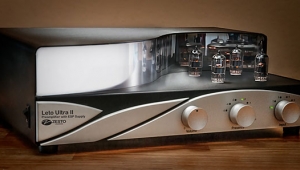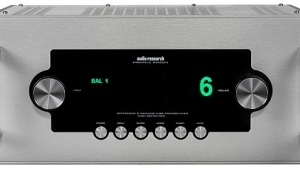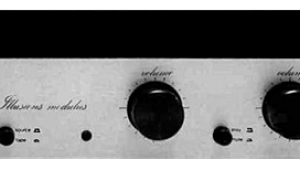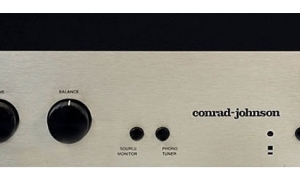| Columns Retired Columns & Blogs |
Conrad-Johnson CT5 line preamplifier
If you review hi-fi long enough, you get to the point where you've heard it all before. Actually, there are several versions of that point: One is where you've heard all the claims before, and the other is where you could have sworn you've actually heard this component before.
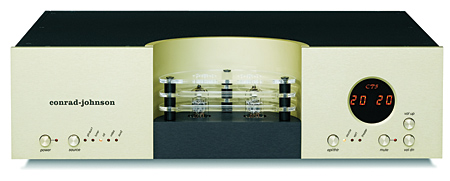
In the case of Conrad-Johnson's $7500 CT5 preamp, I got to both of those points, in a sense. The remote-controlled CT5 is essentially a simplified version of C-J's $13,500 ACT2, which was itself a single-chassis reimagining of the ART2 and its predecessor, the ART. Where the ACT2 created composite triodes by paralleling the four sections of two 6N30P twin-triode tubes per channel—see my review in the March 2005 issue—the CT5 creates a composite out of the sections of a single tube per channel.
Two tubes instead of four means that the CT5 requires a less beefy power supply. In audio—all things remaining equal—simpler generally means better. So the CT-5 ought to be about half as complex as the ACT2, or twice as good for about half the price, right?
If only life were that simple, I might have heard it all before.
Nothing is so simple that it cannot be misunderstood
In some ways, the CT5 is that simple. Like the ACT2, the CT5 uses a single active element per channel and, also like its predecessor, the CT5 has low output impedance—although, because it parallels two triode sections rather than four, its output impedance is slightly higher at 800 ohms than the ACT2's specified >500 ohms. You're probably asking yourself why the CT5 doesn't have twice the output impedance of the ACT2 if it has half the tubes. It's because C-J runs more current through the CT5's triodes.
Like the ACT2, the CT5 employs a microprocessor-controlled, metal-foil, 100-step resistor-ladder volume control. It has Theater throughput, tape loops, and switching for five line-level sources—all remote-controllable, of course.
The big differences between the ACT2 and CT5 lie in their power supplies. But Conrad-Johnson has been building top-of-the-stack preamplifiers for over 25 years—how much can they still have to learn about power supplies?
"It's amazing how much stuff there is left to learn after you think you know it all," chuckled Lew Johnson. "Bill Conrad 'had some ideas' that taught us a lot, so we constructed the CT5 a little differently. Instead of cascading the power-supply regulators as we did in the ACT2, we build more storage and filtering into a single regulator. The CT5 has fewer regulators but a greater amount of storage, relatively speaking. With half as many tubes, we can cut the storage in half and keep it at the same level relative to the current."
Bill Conrad filled in a few gaps for me. "It gets tricky because you're essentially taking something that's fundamentally 120Hz—that's 60Hz after rectifying it—and eliminating what makes it 120Hz."
How's that?
"To remove the various noise components that come over the power line, you have to reduce them remarkably far down into the signal to make them negligible. At the same time, you need to provide a sufficient current supply—ideally, one that would produce infinite availability at zero resistance—which just doesn't happen in the real world. But by combining the two reservoirs, we were able to improve what is available to the active stage—and, in doing so, we halved the noise of any single reservoir."
Honest to God, that all made perfect sense when Conrad was saying it to me—and when I was listening to the CT5. Blame any incomprehensibility on the intermediary.
The truth is rarely pure and never simple
I'd been using the ACT2 as my reference preamplifier, so you'd think that plugging in the CT5 in its stead would have been simple. It was and it wasn't. First, as with the ACT2, the CT5's Teflon capacitors made the sound seriously off-putting when the preamp was initially installed. You have to pump a lot of music through those things before they start to sing—the best part of a week of continuous play.

Another small detail delayed my immersion in the sound: The output impedance difference means the CT5 is more sensitive to cable differences than the ACT2 (or, indeed, many other preamplifiers). High-capacitance cables are probably not a good match, unless you're seriously jonesing after that old-fashioned "tube warmth." (That's a joke, son.) Ditto, probably, long interconnect runs, although I didn't test that myself.
Other setup considerations were pretty minor. The CT5 drove a wide variety of amplifiers satisfactorily and melded well with lots of different speakers I had on hand. That's not to say the CT5 is immune to system synergy, but give it an amplifier with compatible input impedance and you should do all right.
Life is like art—you have to work hard to keep it simple
Once burned in, the CT5 was virtually indistinguishable from the ACT2 it replaced. Now we could debate long and hard about whether I could walk into a room and identify any preamp immediately, but I did expect that extended auditioning of the CT5 after prolonged exposure to the ACT2 would unearth some differences. To discover otherwise would really harsh my mellow, man. After all, the audio magazine that published equipment reports claiming that everything sounded alike went out of business. When things start sounding the same, my career's in jeopardy, right?
- Log in or register to post comments







